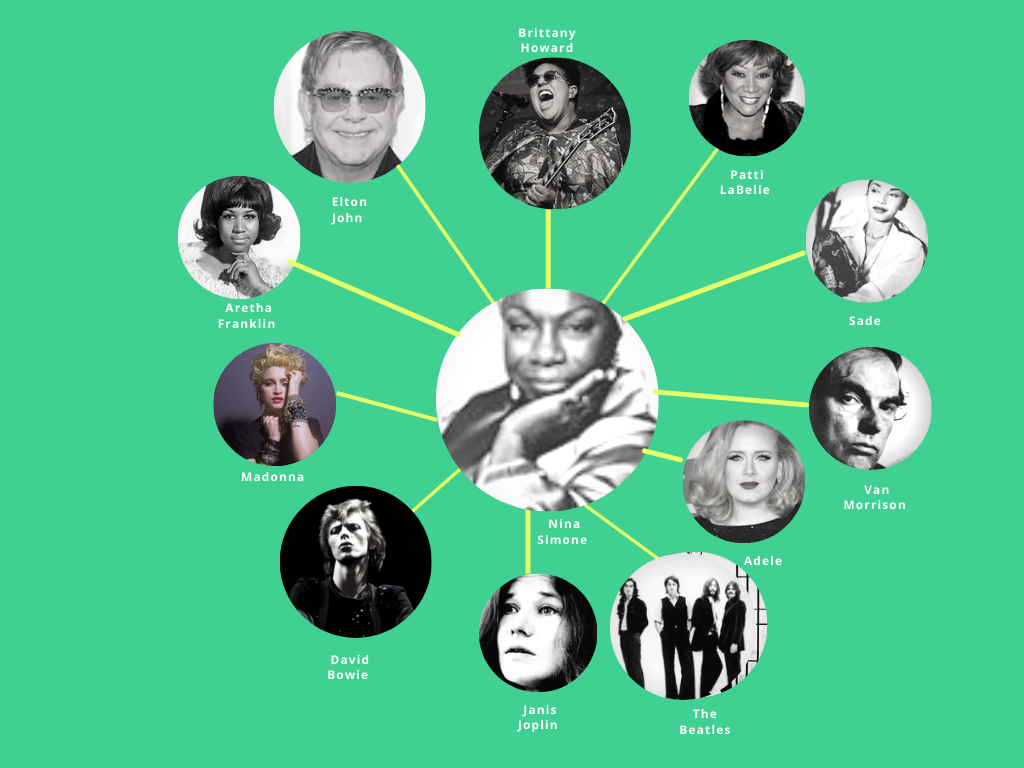
Welcome to another Musical Tree! In this edition we will examine an artist whose influence doesn’t just spawn a Musical Tree, one could argue that it’s a Musical Forest! Let’s get ready to learn about the multi-talented classical, jazz, blues, and gospel of Nina Simone!
Born in 1933 to a poor family in North Carolina, Eunice Kathleen Waymon was the sixth of eight children. She initially desired to be a concert pianist and began performing at a young age. It did not take her long to join in the fight for civil rights. Performing her first concert at the age of 12, she became outraged when her parents, who were seated up front, were moved to the back to make room for white audience members. She refused to perform until her parents were seated at the front of the audience.
A few years later she received an audition at the Curtis Institute of Music in Philadelphia. Despite playing a very well-received audition, she was denied admission, which she attributed to her race. Undeterred, she enrolled at the Julliard School of Music in New York City. However, being able to afford attending school and living in New York meant that she would need to get a job. It was this decision that would have a profound impact on her musical career.
She landed a job playing piano at a nightclub in Atlantic City. Her parents were strict Christians so Eunice Waymon decided that she better change her name to prevent her parents from discovering that she was playing “the devil’s music”. Inspired by the names ‘Nina’, meaning little girl in Spanish, and ‘Simone’, taken from French actress Simone Signoret, Nina Simone would rise to fame without her parents’ knowledge.
In 1958 she recorded George Gershwin’s song ‘I Loves You, Porgy’, (from the musical ‘Porgy and Bess’) which she had learned from a Billie Holiday album. You can hear her classical training at the beginning of the track, and throughout the song her brief but great piano fills grab your attention. The single quickly rose up the charts and became the only Top 20 hit in her career in the United States. This was followed by her debut album ‘Little Girl Blue’, which also sold well. However, because she had sold her rights outright for $3000, she lost more than $1 million in royalties as her popularity grew and her early songs were re-released decades later. Her dedication to music never faltered and she was a prolific musician, recording more than forty (!) albums between 1958 and 1974.
As her recording career continued to grow so did her role in the civil rights movement. In 1964 she released a live album titled ‘Nina Simone in Concert’, which contained the first song she ever wrote that took direct aim at the civil rights movement. The song ‘Mississippi Goddam’ was her response to the Birmingham Church Bombing and the murder of Medgar Evers. The song was released as a single and was boycotted throughout the South, with some stations smashing the record to pieces and mailing it back to Simone.
From this point forward, Nina made it a point to include civil rights messages in her live performances. She performed at many civil rights gatherings, including the march from Selma to Montgomery. Even though her views on civil rights conflicted with those of Martin Luther King Jr., later in her life when she wrote her autobiography she stated that her and her family regarded all races as equal.
Her 1968 album ‘Nuff Said’ contained live recordings from her appearance at the Westbury Music Fair on April 7, 1968 – just three days after the assassination of Martin Luther King Jr. She dedicated the performance to him and played a song titled ‘Why? (The King of Love is Dead)’, written by her bass player. Later, Nina would reflect that the song ‘Mississippi Goddam’ hurt her career, believing that the music industry was punishing her by boycotting her records.

In 1970 she fled the United States to Barbados. A warrant had been issued for her arrest for failing to pay her taxes. Nina had refused to pay taxes as a way to protest U.S. involvement in the Vietnam War. After leaving the U.S. her marriage to Andrew Stroud (also her manager) collapsed over a misunderstanding. When Nina fled to Barbados, she left her wedding ring behind, intending to come back for it. Her husband saw it differently and filed for divorce. Her marriage in shambles, Nina began a lengthy affair with the Prime Minister of Barbados, Errol Barrow.
Once the affair ended and for the rest of her life Nina Simone lived in Europe, in both the Netherlands and France. She continued to record and perform live. In 1988 she had a huge European hit when she re-recorded her song ‘My Baby Just Cares For Me’. The song had recently been used in a commercial for Chanel No. 5 Perfume in Europe, and her re-release of the song soared to the top of the European charts. By this time, she had settled her tax issues in the United States, and occasionally flew back to the U.S. to perform. However, she had developed health issues that were taking their toll. She was diagnosed with bi-polar disorder and, in the mid 1990’s, with breast cancer. At a concert in Newark, New Jersey in 1998 she told the audience that “If you’re coming to see me again, you’ve got to come to France because I am not coming back”. In 2003 Nina Simone died in her sleep at her home in France. Her ashes were spread in several African countries.
The influences that Nina Simone had on other performers is truly amazing. Elton John named one of his pianos after her. As mentioned in a previous Reverse Musical Tree on Brittany Howard, who also lists Nina as a huge influence, John Lennon stated that Nina’s version of ‘I Put A Spell on You’ was a big influence on the Beatles song ‘Michelle’.
The list of artists Nina Simone influenced goes on and on. To list just a few:
- Aretha Franklin
- Adele
- Madonna
- David Bowie
- Patti LaBelle
- Sade
- Janis Joplin
- Van Morrison
- Mos Def
- Lena Horne
- Bono
- John Legend
- Cat Stevens
- Peter Gabriel
- Justin Hayward
- Mary J. Blige
- Alicia Keys
- Jay-Z
- Common.
Just pause to consider the musical success and musical diversity of these artists!
Nina’s songs have appeared on soundtracks of dozens of movies, everything from ‘La Femme Nikita’ to ‘Any Given Sunday’. Even ‘The Big Lebowski’ featured her song ‘I Got It Bad And That Ain’t Good’!
Rolling Stone magazine named her the 29th greatest singer of all time, writing of her ability to “belt barroom blues, croon cabaret, and explore jazz – sometimes on a single record”. She was awarded a Grammy Hall of Fame award in 2000 for her version of ‘I Loves You, Porgy’. In 2018 she was inducted into the Rock and Roll Hall of Fame by Mary J. Blige. Fittingly, in 2019 her song ‘Mississippi Goddam’ was selected by the Library of Congress for preservation in the National Recording Registry for being “culturally, historically, or aesthetically significant.”
In reflecting on Nina Simone’s legacy, it’s difficult to distinguish how much was due to her music versus her civil rights activities. While one might not always agree with her methods, much like Muhammed Ali when he protested the Vietnam War, she chose to use her voice to call attention to racial inequalities. Even though music is a great escape for the listener, artists have often used it as a medium to get across a message. To fail to recognize that connection with Nina Simone’s music would be a true injustice.
Oh, and two days before she passed away, Nina Simone received word that she had been awarded an honorary degree by the Curtis Institute of Music, the same institution that denied her admittance when she was a young woman.
I hope you enjoyed this week’s Musical Tree! Feel free to leave suggestions for future articles in the comments. Don’t forget to subscribe to be notified via email when there is a new post.
And you can now follow Tekesmusings.com on your social media of choice by clicking on the links at the bottom of the page! Until then, follow your passion, stay happy, and be thankful for whatever inspires you.


